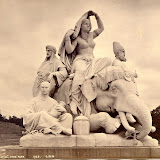… I can impart but little of what we felt. We were still on the same side of the water, and, being immediately under the hill, within a considerable bending of the shore, we were enclosed by hills all round, as if we had been upon a smaller lake of which the whole was visible. It was an entire solitude; and all that we beheld was the perfection of loveliness and beauty.
Dorothy Wordsworth; Recollections of a Tour Made in Scotland AD 1803, pub; 1804
Firstly, there is his name. His parents were crofters; Scottish farmers who rented a small holding, were denied a vote, and they christened him George Washington in 1823, in the midst of the notorious Highland clearances. To name a son after the victorious general in the War of Independence was a blunt political statement. The boy became court photographer to Queen Victoria and took one of the most iconic images of her, mounted on a horse, her footman, John Brown, holding the bridle, the scene swathed in a moody fog. The journey from a small farm in Aberdeen to Buckingham Palace was not so much difficult as unlikely. So, did Wilson’s success involve a betrayal of his family’s principles?
George Washington Wilson was the most British of photographers. His landscapes, particularly of Scotland, belong more to a sensibility in literature than the visual arts. His contemporaries among painters, Turner especially, tend to pit nature against society. Light and fog smother cities and obliterate detail, the sea threatens to smash ships to splinters. In novels like Emily Brontë’s Wuthering Heights the characters inhabit the landscape and are shaped by it. Ditto Thomas Hardy, Walter Scott and R. D Blackmore. Wilson’s photographs worship nature yet celebrate human intervention. The rugged highland valley has a road cut through it. A boat rests on the lakeshore. Gloomy skies embrace the ruins of churches. People seldom dominate the frame; rather they are figures in a setting; distant, anonymous farm labourers or fishermen.
On the evening of the 3rd of May, 1827, the garden of a large red brick bow windowed mansion called Northend House, which, enclosed in spacious grounds, stands on the eastern side of Hampstead Heath, between Finchley Road and the Chestnut Avenue, was the scene of a domestic tragedy.
Marcus Clarke: For the Term of his Natural Life, pub; 1870-1872
A common literary device in Victorian novels and short stories was to open with a panoramic description of a village or the landscape. The church, the house or tavern at the centre of the drama was first given context by the surroundings from which the tale’s atmosphere developed. Sensationalists especially understood that a bucolic setting was the best place to begin a tale of shocking scandal or heartrending tragedy. Wilson’s landscapes could be the opening paragraph to a Victorian novel; a scene of quiet rural splendour luring the reader into a series of disastrous events.
Aesthetically Wilson was a Romantic, which marked him as a patriot in temperament if not actual politics. Whatever his position on Scottish nationalism, his image of Scotland, the brew of wilderness and human spirit, was shared by the English, who regarded it as essentially the same country as theirs, and by one woman in particular.
Queen Victoria and Prince Albert shared an attested enthusiasm for photography: there is a story that on the day she proposed marriage she opened proceedings with her husband-to-be by discussing some examples of a new process that had come her way, daguerreotypes. An amateur herself, her patronage of photographers would establish the reputations of several studios within Britain, including Wilson’s. What she though of his name was neither here nor there. It shouldn’t be forgotten that although hers is forever associated with prudishness, she bought a print of Oscar Rejlander’s Two Ways of Life with its phalanx of naked women when galleries were loathe to exhibit it.
In 1852 Queen Victoria bought Balmoral Castle as a summer residence. The new building, partly designed by Prince Albert, echoed a medieval mythology. It featured neo-gothic spires, turrets and domes and was set in parkland fronting the Dee River. The estate contained all the essential elements for a highland retreat; a deer park, forests for hunting, streams for fishing and mountainous crags for wandering through. Wilson, whose studio was in nearby Aberdeen, was hired first to take photographs of the construction, later the interiors and eventually, as official photographer, portraits of the royal family.
The first paragraph ended with a question that can’t be answered but that shouldn’t preclude its being asked. Wilson’s Scottish landscapes are a manifestation of national consciousness, nostalgia for a country that had been taken away from its people. The mid 19th century, the era of the highland clearances, was also the time when the foundation myths of Scottish nationalism, the 1692 massacre at Glencoe, William Wallace, Culloden, were taking form. A true Scottish photographer needed a deep feeling for his country. Maybe it was those qualities that attracted Victoria and Albert in the first place. Their standards and expectations were high. Anything less than a profoundly poetic eye would have disappointed them.
Visit the Gallery Here
 |
| GEORGE WASHINGTON WILSON |


No comments:
Post a Comment
Add comments here